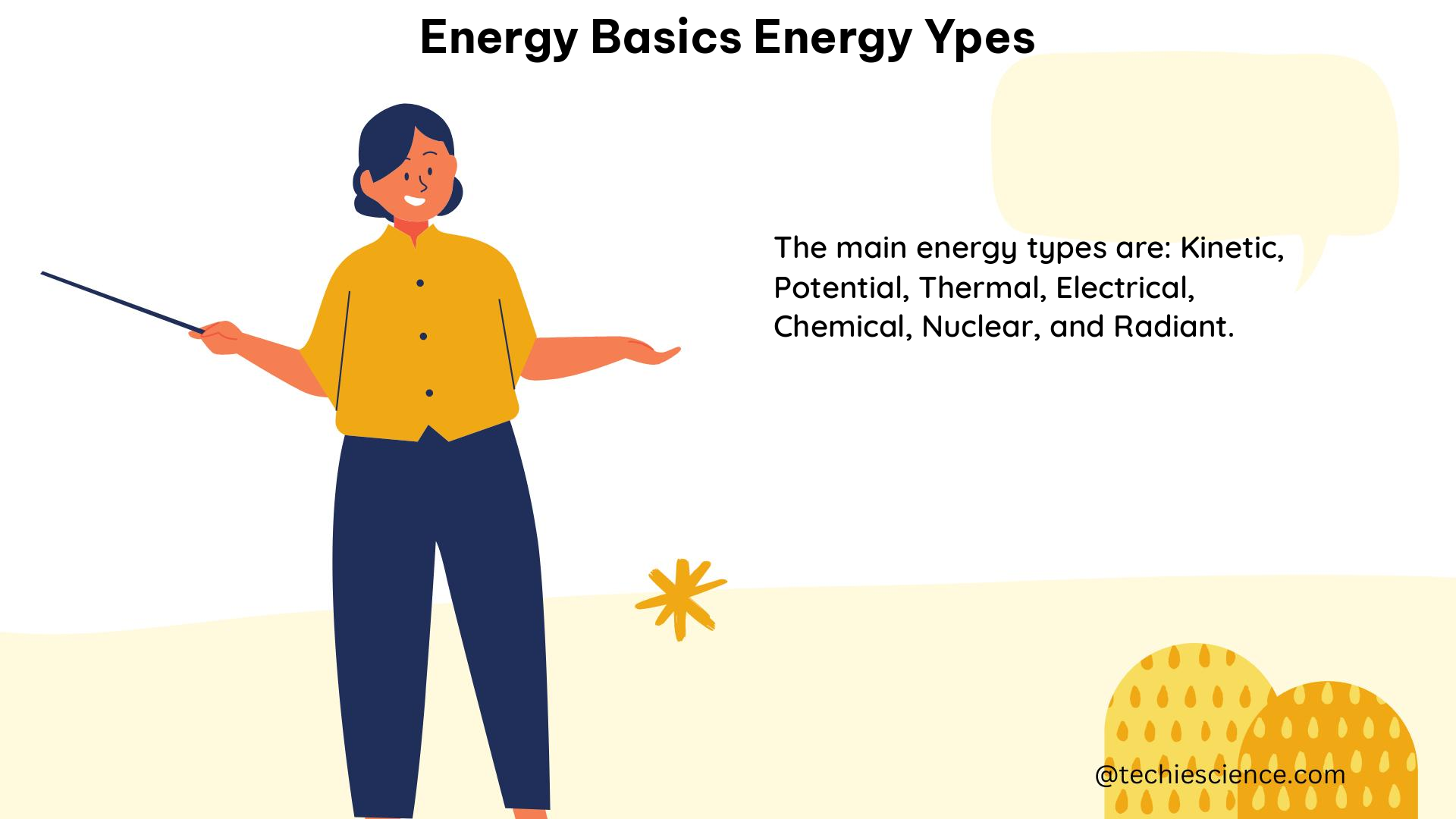Energy is a fundamental concept in physics, and understanding its various forms and properties is crucial for students studying this field. This comprehensive guide delves into the intricacies of energy basics and types, providing a wealth of technical details and quantifiable data to help physics students deepen their understanding.
Energy Basics
Definition of Energy
Energy is the capacity to do work, and it is measured in the International System of Units (SI) using the unit of Joules (J). Energy can be classified into two main types: kinetic energy (the energy of motion) and potential energy (the energy due to position, composition, or condition).
Conservation of Energy
The law of conservation of energy is a fundamental principle in physics, stating that energy cannot be created or destroyed, but can only be converted from one form to another. This principle is expressed mathematically as:
ΔE = 0
where ΔE represents the change in total energy of a closed system over time.
Energy Types

Kinetic Energy (KE)
Kinetic energy is the energy of motion, and it is given by the formula:
KE = 1/2 * m * v^2
where m is the mass of the object and v is its velocity. The unit of kinetic energy is Joules (J).
Example: A 2 kg ball moving at a velocity of 5 m/s has a kinetic energy of 25 J.
Potential Energy (PE)
Potential energy is the energy due to position, composition, or condition, and it can take various forms:
- Gravitational Potential Energy (GPE): The energy an object possesses due to its position in a gravitational field, given by the formula:
GPE = m * g * h
where m is the mass of the object, g is the acceleration due to gravity, and h is the height of the object.
Example: A 5 kg object lifted to a height of 2 m has a gravitational potential energy of 98 J.
- Elastic Potential Energy (EPE): The energy stored in an object due to its deformation, given by the formula:
EPE = 1/2 * k * x^2
where k is the spring constant and x is the displacement of the object from its equilibrium position.
Example: A spring with a spring constant of 100 N/m compressed by 0.2 m has an elastic potential energy of 2 J.
- Chemical Potential Energy (CPE): The energy stored in the chemical bonds of atoms and molecules, released during chemical reactions.
Example: The chemical potential energy stored in a gallon of gasoline is approximately 132 MJ.
Thermal Energy
Thermal energy is the energy associated with the temperature of a substance, and it is measured in Joules (J). It is the kinetic energy of the atoms and molecules that make up a material.
Example: A 2 kg block of copper at a temperature of 50°C has a thermal energy of approximately 418 kJ.
Electrical Energy
Electrical energy is the energy associated with the movement of charged particles, and it is also measured in Joules (J). This energy is used to power electrical devices and systems.
Example: A 100 W light bulb consuming 1 kWh of electrical energy over an hour has used 3.6 MJ of electrical energy.
Chemical Energy
Chemical energy is the energy stored in the bonds of atoms and molecules, and it is released during chemical reactions, such as combustion. It is measured in Joules (J).
Example: The chemical energy stored in a piece of coal with a mass of 1 kg is approximately 30 MJ.
Measurable and Quantifiable Data
Energy Units
- Joules (J): The SI unit of energy, used to measure all forms of energy.
- Calories (cal): A unit of energy often used in nutrition and chemistry, where 1 calorie is approximately equal to 4.184 Joules.
- Kilowatt-hours (kWh): A unit of energy used to measure electrical energy consumption, where 1 kWh is equal to 3.6 million Joules.
Energy Conversion
Energy can be converted from one form to another, such as from chemical energy to thermal energy during combustion. The efficiency of these conversions is an important consideration in energy systems.
Example: A car engine converts the chemical energy stored in gasoline into the kinetic energy used to propel the vehicle.
Energy Efficiency
Energy efficiency is the ratio of useful energy output to total energy input, often expressed as a percentage. It is an important metric for evaluating the performance of energy systems and devices.
Example: The energy efficiency of a typical incandescent light bulb is around 5-10%, meaning that only 5-10% of the electrical energy input is converted into useful light output, with the rest being lost as heat.
Energy Management Goals
Setting specific, measurable, achievable, relevant, and time-bound (SMART) goals for energy management can help optimize energy usage and reduce waste. These goals can be based on various metrics, such as energy consumption, cost, or environmental impact.
Example: A goal to reduce the electricity consumption of a building by 15% within the next two years, with specific action plans and monitoring mechanisms in place.
By understanding the fundamental concepts of energy, its various forms, and the quantifiable data associated with it, physics students can develop a strong foundation for further exploration and application of energy principles in their studies and future careers.
References
- CLEAN. (2013). Energy Basics. Retrieved from https://cleanet.org/clean/literacy/energy1.html
- Next Generation Science Standards. (n.d.). MS-PS3 Energy. Retrieved from https://www.nextgenscience.org/dci-arrangement/ms-ps3-energy
- Lumen Learning. (n.d.). Energy Basics. Retrieved from https://courses.lumenlearning.com/suny-chem-atoms-first/chapter/energy-basics/
- Dexma. (2023). SMART Goals for Energy Management. Retrieved from https://www.dexma.com/blog-en/smart-goals-for-energy-management/
- Serway, R. A., & Jewett, J. W. (2018). Physics for Scientists and Engineers with Modern Physics (10th ed.). Cengage Learning.
- Halliday, D., Resnick, R., & Walker, J. (2013). Fundamentals of Physics (10th ed.). Wiley.
- Tipler, P. A., & Mosca, G. (2008). Physics for Scientists and Engineers (6th ed.). W. H. Freeman.

I am Subrata, Ph.D. in Engineering, more specifically interested in Nuclear and Energy science related domains. I have multi-domain experience starting from Service Engineer for electronics drives and micro-controller to specialized R&D work. I have worked on various projects, including nuclear fission, fusion to solar photovoltaics, heater design, and other projects. I have a keen interest in the science domain, energy, electronics and instrumentation, and industrial automation, primarily because of the wide range of stimulating problems inherited to this field, and every day it’s changing with industrial demand. Our aim here is to exemplify these unconventional, complex science subjects in an easy and understandable to the point manner.